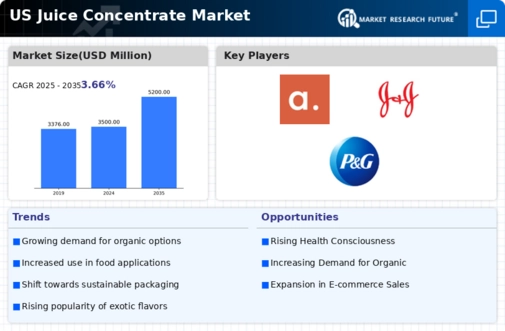Evolving Retail Channels
The evolution of retail channels is a significant driver for the apple juice-concentrate market. With the rise of e-commerce and online grocery shopping, consumers have greater access to a variety of products, including apple juice concentrate. This shift in shopping behavior has led to an increase in sales through online platforms, which are projected to account for 20% of total grocery sales by 2026. Retailers are adapting to this trend by enhancing their online presence and offering promotions for juice products. The apple juice-concentrate market can leverage these evolving retail channels to reach a wider audience, thereby increasing its market share and visibility.
Increased Use in Food Products
The apple juice-concentrate market is experiencing a surge in demand due to its increased utilization in various food products. As food manufacturers seek natural sweeteners and flavor enhancers, apple juice concentrate serves as an appealing alternative to artificial ingredients. This trend is particularly evident in the production of baked goods, sauces, and dressings, where apple juice concentrate adds flavor and nutritional value. The market for natural food ingredients has grown by approximately 10% annually, suggesting a favorable environment for apple juice concentrate. This trend indicates a potential for expansion within the food sector, further solidifying the apple juice-concentrate market's position in the industry.
Growth of the Beverage Industry
The overall growth of the beverage industry in the US significantly impacts the apple juice-concentrate market. With the beverage sector projected to reach $200 billion by 2026, the demand for various juice products, including apple juice concentrate, is expected to rise. This growth is driven by a shift towards non-alcoholic beverages, as consumers increasingly opt for refreshing and flavorful alternatives. The apple juice-concentrate market stands to benefit from this trend, as manufacturers innovate to create new products that cater to evolving consumer tastes. The industry's ability to adapt and introduce diverse offerings will likely enhance its competitive edge and market presence.
Health Consciousness Among Consumers
The increasing awareness of health and wellness among consumers is a pivotal driver for the apple juice-concentrate market. As individuals seek healthier beverage options, the demand for natural and nutritious products rises. Apple juice concentrate, known for its vitamins and antioxidants, aligns well with this trend. According to recent data, the market for health-oriented beverages has expanded by approximately 15% annually, indicating a robust consumer shift towards healthier choices. This trend is likely to continue, as more consumers prioritize their health, thereby propelling the apple juice-concentrate market forward. The industry must adapt to these changing preferences by emphasizing the health benefits of apple juice concentrate, potentially leading to increased market share and profitability.
Rising Popularity of Functional Beverages
The apple juice-concentrate market is positively influenced by the rising popularity of functional beverages. Consumers are increasingly seeking drinks that offer health benefits beyond basic nutrition, such as enhanced hydration and immune support. Apple juice concentrate, rich in vitamins and antioxidants, fits well within this category. The functional beverage market is projected to grow at a CAGR of 8% over the next five years, indicating a strong consumer interest in products that promote health and wellness. This trend presents an opportunity for the apple juice-concentrate market to innovate and develop new functional beverage options, potentially attracting a broader consumer base.














Leave a Comment